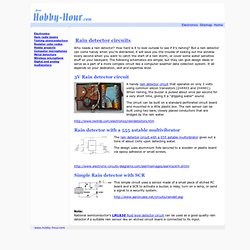

Www.steeman.be » Load cell amplifier. This page describes the construction and operation of a device for testing rocket motors.

It allows the recording of the thrust generated by the motor during a static test. The recorded data is then analyzed using an Excel spreadsheet. This load cell amplifier is a little different from the other designs usually found on the internet. It has the analogue-to-digital converter (ADC) on board, which means that the use of a separate ADC (e.g. a Dataq unit) is not required. This load cell amp plugs directly into a USB port and presents itself to the computer as a regular COM port.1.1. Digital Scale Strain Gauge Weight Sensor. We took a $20 digital scale from Target and hooked it up to an amplifier and a microcontroller.

This video outlines taking apart the scale, wiring it to the amplifier, and the code, as well as an overview of the concepts behind strain gauges and Wheatstone bridges. There's a demo of two live scale apps written in Python near the end of the video. Note: there's a lot going on in this project, from the cantilever bending to the bridge noise cancellation to the PC graphics code. It's a complicated one, so take it slow. You can download the microcontroller source code. Take a look at more videos and microcontroller projects! HEATED TIPPING BUCKET. The days of manually measuring precipitation with a bucket and ruler or with a strip chart weighing gauge are coming to an end.

With the introduction of ASOS, came the need for an automated precipitation accumulation gauge, or, at least for the present, an automated rain-only gauge. The current precipitation accumulation gauge ASOS uses is a heated tipping bucket manufactured by the Frise Engineering Company of Baltimore, MD (see figure Page 2). Essentially, it is a revamped version of the old Belfort tipping bucket, widely used for decades. Today's Frise Tipper uses several design modifications that have either solved or mitigated a number of performance flaws in the original design. Using the Insect Eavesdropper. If you've flipped it on and started listening to stuff, then you know it can be used for much much more than eavesdropping in on cricket conversations.

I point it to the highway and can hear cars with snowtires on. I can hear creaking wood in the house and the sound of my feet scuffling across the carpet is deafening. Make sure you use the volume knob judiciously. It acts as sort of a squelch, as well. Experiment and have fun. What else can you use it for? Replace the piezo mic with six to eight turns of 26-gauge magnet wire wound in a 3x5 foot loop and you can hear atmospheric noises such as lightening, the wind, even distant auroras can be heard with a high-gain amplifier. Piezoelectric Sound Meter. NerdKits was recently a sponsor of MIT's Battle of the Bands 2009, a fundraising event which supports the Children's Miracle Network, and also is a popular gathering during MIT's Campus Preview Weekend for incoming students.

To show off our microcontroller kits during the event, we built a sound meter which uses the piezoelectric buzzer (included with our USB NerdKit microcontroller kit) in reverse, as a microphone. This provides an opportunity to demonstrate a single transistor amplifier, to make the signals from the piezoelectric element big enough for the microcontroller's analog-to-digital converter (ADC) to read. Since our sound level meter had to be visible in a big room (the Lobdell food court in MIT's Student Center), we opted to use our bright red LED Marquee, which has 120 high-intensity red LEDs all controlled by the one ATmega168 microcontroller. Here are a few photos of the finished product: (click to enlarge) IC = β IBIB = IS eVBE/Vth dVOUT / dIC = - RC dVBE / dIC = Vth / IC. Make an acoustic rain gauge (disdrometer) For a project at Delft University of Technology (The Netherlands) we are building cheap, durable acoustic rain gauges, known as disdrometers.
These devices "listen" to the rain and calculate the rain rate from the acoustic signal. But you can also listen to the signal: that way, you can hear the rain, even when inside a cubicle. A nice way to bring the outside environment into the office, without getting wet. The disdrometer presented here is better for "listening", since this instructable competes in the "Art of Sound" contest. In a future instructable, a version that is optimized for measuring rain will be presented. Acknowledgements: This instructable is based on the work of Coen Degen, student at Delft University of Technology, whom I had the privilege to supervise. Rain detector circuits. Who needs a rain detector?

How hard is it to look outside to see if it's raining? But a rain detector can come handy when you're distracted; it will save you the trouble of looking out the window every second when you want to catch the start of a rain storm, or cover some water sensitive stuff on your backyard. The following schematics are simple, but they can give design ideas or serve as a part of a more complex circuit like a computer weather data collection system. It all depends on your dedication, skill and expertise level. 3V Rain detector circuit A handy rain detector circuit that operates on only 3 volts using common silicon transistors (2n4403 and 2n4401).